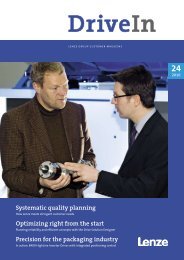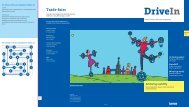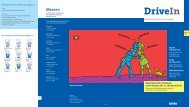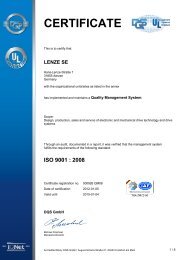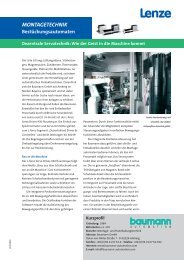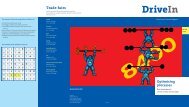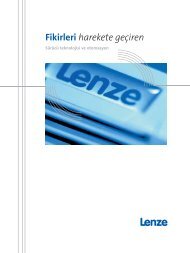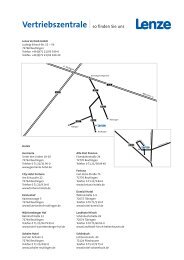Trade fairs - Lenze
Trade fairs - Lenze
Trade fairs - Lenze
Create successful ePaper yourself
Turn your PDF publications into a flip-book with our unique Google optimized e-Paper software.
systems. As a result, the Caviflex family<br />
of machines has a wide range of uses.<br />
The machines are characterised by high<br />
processing speeds, reliable operation,<br />
quick installation and commissioning,<br />
and ease of maintenance.<br />
<strong>Lenze</strong> servo technology plays an<br />
important role in all of this. It is used to<br />
drive the various processes with the<br />
necessary accuracy and synchronicity. In<br />
its Caviflex series, Santex makes use of<br />
MCS servo motors combined with the<br />
ECS servo system manufactured by the<br />
Hameln-based drive specialists. These<br />
controllers cover a power range of<br />
between 1.1 and 13.8 kW, and can be<br />
overloaded by a factor of 3.2. <strong>Lenze</strong><br />
supplies the ECS drive system with four<br />
different software versions covering<br />
commonly occurring applications –<br />
almost the entire spectrum from the<br />
simple servo controller all the way to<br />
complex Cam functions. The ECS axis<br />
modules can, however, be used to fulfil<br />
very specific requirements, since it is<br />
possible to program the axis yourself.<br />
The program and control structures are<br />
written in the languages of IEC 61131-3.<br />
Santex chose this option in order to<br />
ensure that the axis modules for all of<br />
its machine models were perfectly suited<br />
to the application.<br />
To Carmelo Nastasi, Director of<br />
Electrical Engineering at Santex, the<br />
advantages of this approach are clear to<br />
see: “Having complete freedom of programming<br />
in the axis controllers was<br />
the only way of satisfying our very particular<br />
requirements with a minimum of<br />
hardware and engineering.” The flexibility<br />
of these drive controllers was a major<br />
factor in helping Santex optimise the<br />
cost side of its Caviflex laminating and<br />
Professional footballers wear functional<br />
fabrics.<br />
coating systems without placing limitations<br />
on their performance or ease of<br />
use.<br />
The result is a system in which users<br />
have access to all four currently used<br />
coating processes in one machine without<br />
time-consuming conversion work.<br />
The time which would otherwise be<br />
used to refit and then restart the<br />
machine can now be used to continue<br />
production. This reduces production<br />
costs. Since all of the ECS axis modules<br />
come with a “Safely deactivated torque”<br />
(safe standstill) function as standard<br />
without additional external components,<br />
maintenance staff can perform their<br />
servicing work on the machine at short<br />
notice without a need for time-consuming<br />
shutdown and switching-off processes.<br />
As well as the high level of flexibility<br />
offered by the drive controllers, the comprehensive<br />
communications support<br />
incorporated into the ECS servo system<br />
enables users to make use of three bus<br />
systems working in parallel. A Caviflex<br />
machine may have up to 22 ECS axis<br />
controllers depending on the version,<br />
and these are supplied with all of the<br />
Sporting textiles<br />
In action<br />
During hard training sessions and while<br />
competing, the clothing of a sportsperson<br />
wicks between 1.5 and 2.5 litres of liquid.<br />
How comfortable the clothing is to wear<br />
from a physiological point of view – which<br />
means the material’s breathability, dampness<br />
and ability to manage heat – plays a<br />
major role in supporting an athlete’s performance.<br />
Traditional clothing made from cotton<br />
absorbs sweat well but does not release<br />
it again effectively. It is for this reason<br />
that functional textiles were developed<br />
from man-made fibres around 25 years<br />
ago.<br />
Optimum comfort and the wicking away<br />
of body moisture can only be achieved if<br />
the various items of clothing complement<br />
one another. The first layer, directly next to<br />
the body, should draw sweat and moisture<br />
away from the skin. The surface area of the<br />
fibres, and thus the fabric’s wicking capacity,<br />
can be increased by changing the fineness<br />
and profile of the fibres. Graduating the<br />
fineness of fibres and threads from the<br />
inside to the outside of the fabric’s crosssection<br />
allows moisture to evaporate even<br />
more effectively.<br />
The functional clothing worn near to the<br />
body is supplemented by weatherproof<br />
jackets. These must of course be breathable,<br />
which is achieved using membrane<br />
systems made up of a range of chemical<br />
fibres. The pores in the material are smaller<br />
than the smallest water drop but larger<br />
than a water molecule, which means that<br />
sweat can pass through to the outside as<br />
vapour. The jackets are made waterproof<br />
by a laminating process in which the membrane<br />
is bonded to the fabric layer. During<br />
the coating process, a thin layer of plastic<br />
(usually polyurethane) is applied in liquid<br />
form straight onto the fabric, where it<br />
hardens. This makes the jacket completely<br />
watertight, but without allowing sweat to<br />
make the inside damp.<br />
www.hohenstein.de<br />
13




